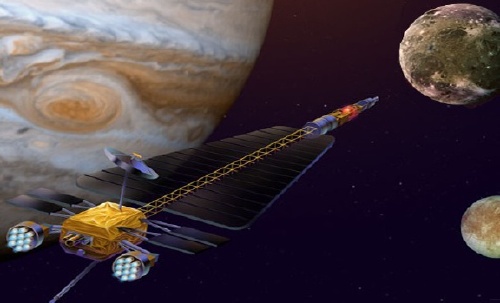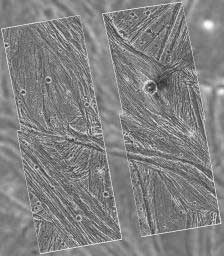 |
|||||
|---|---|---|---|---|---|
| EXPLORING THE JUPITER SYSTEM | |||||
| Jupiter | Moons | Oceans | Volcanos | Rings | Radio |
| JIMO | Galileo | Cassini | Pioneer | Voyager | Resources |
The Jupiter Icy Moons Orbiter:
Ganymede is the Largest Solar System Moon
Ganymede is not only the largest natural satellite of Jupiter, but also the largest moon in our Solar System.
Jupiter's moon Ganymede
It's diameter is 3,280 miles. Ganymede could be classified as a planet if it orbited the Sun instead of the planet Jupiter. In fact, it's bigger than the planets Mercury and Pluto and almost as big as Mars. It's nearly half as big as Earth, which has a diameter of 7,926 miles. MOON DIAMETERS
Ganymede would be the second moon explored by the Jupiter Icy Moons Orbiter, after Callisto.
Above the surface. Until recently, scientists thought Ganymede has no atmosphere. Recently, however, the Hubble Space Telescope detected ozone at the surface of the big moon. Of course, the amount of ozone is small when compared to Earth.
The ozone probably is produced when charged particles trapped in Jupiter's magnetic field fall on the moon's surface. As the particles penetrate the ice, particles of water are disrupted leading to a chemical process generating ozone.
If that assumption is correct, Ganymede probably has a thin oxygen atmosphere similar to that detected on the moon Europa.
On the surface. Ganymede has mountains, valleys, craters and lava flows. It shows both dark and light regions.The grooves probably were formed more recently than the dark cratered areas indicating Ganymede has had a complex geological history.
- In the dark regions, the moon is more heavily cratered, which suggests an ancient origin.
- In the bright regions, the terrain is grooved with ridges and troughs. The ridges reach heights of several hundred feet and the grooves run for thousands of miles in complex patterns.
Beneath the surface. Ganymede may be like Callisto with a crust of rock and ice, a water-ice mantle, and a rocky core.
The moon has a low density, which suggests the core takes up about half of the satellite's diameter.
The crust probably is a thick layer of water ice, and the mantle probably is ice and silicates. At some places the crust has spread and separated.
A view of the surface. The NASA photo at right shows the surface of Jupiter's icy moon Ganymede as recorded by the Galileo spacecraft in 1996. The background image, behind the two panels, is a photo of Ganymede made in 1979 by the Voyager 2 spacecraft.
Surface of the moon Ganymede
click to enlarge Galileo image
The area shown in the Galileo photo is the Uruk Sulcus region of Ganymede. The picture covers about 75 by 68 miles, and was taken at a distance of 4,628 miles from Ganymede.
The photo reveals the parallel ridges and troughs that are the principal features in the brighter regions of Ganymede's ice-rich surface.
Resolution of the Galileo images is 243 feet per pixel, while resolution of the Voyager image is 4,224 feet per pixel. That means the Galileo photos are relatively high-resolution and the Voyager picture is low-resolution. Thus, the Voyager picture in the background appears fuzzy.
Pixel is an abbreviation for the term picture element. A pixel is the smallest picture element of a digital image. While individual pixels are too small to notice, together they make up an entire picture.
Source: NASA Jet Propulsion Laboratory
Diameters of the Largest Satellites and the Planets miles miles Mercury 3,031 Saturn 74,901 Venus 7,521 Titan 3,200 Earth 7,927 Rhea 949 Moon 2,160 Iapetus 892 Mars 4,222 Dione 696 Jupiter 88,848 Tethys 650 Ganymede 3,274 Uranus 31,765 Callisto 2,986 Titania 981 Io 2,256 Neptune 31,404 Europa 1,945 Triton 1,678 Pluto 1,440 Charon 790
Learn more about Jupiter and its moons and rings:
Solar System Search STO STO cover Questions Feedback Suggestions © 2004 Space Today Online

